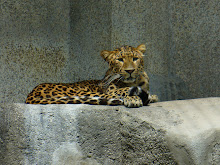First Link-of-the-day today is this to gallery of pictures of baby sloths from a wildlife resuce centre in Costa Rica: sloths don't generally rank highly on most people's lists of cute animals: these pictures may change your mind-
http://thestar.blogs.com/photodesk/2010/08/the-daily-beast-august-29-2010.html
Today's second link is this article reporting research into solar panels/ photosynthesis: according to the link, scientists at MIT have created a synthetic process that imitates photosynthesis. By combining phospholipids and carbon nanotubes, they have been able to produce a "self-assembling solar panel": this is an over simplification, of course, the details are here-
http://dvice.com/archives/2010/09/scientists-disc.php
Thursday, 16 September 2010
Tuesday, 14 September 2010
Link of the day- bull-sharks, ants, trees and elephants...

Image: Bullshark- photographed in Beqa Lagoon, Fiji by Terry Goss (Mr Goss is known as "Pterantula" on flikr- you can find his photostream [here])This image has a GNU free documentation licence- details [here]
Hi. Welcome (back) to Weirdbeautiful.
First link-of-the-day today is this article in the New York Times (and International Herald Tribune) talking about how ants living in certain specific trees protect them from elephant attack- essentially by swarming and biting any approaching elephants. The ants, which feed on a sweet secretion released by the tree, thereby protect the tree from damage/being eaten and safeguard their own food source and habitat. The full length article gives more details-
http://www.nytimes.com/2010/09/07/science/07obants.html?ref=science
The second link-of-the-day is this blog post by J. Freedom du Lac from The Washington Post; it talks about an 8-foot (2.4 metre) long bull shark (Carcharhinus leucas) being caught in the Potomac river in Maryland, USA. This is further north than the species' usual range, but the creatures are believed to be feeding on rays and crabs in Chesapeake Bay. The post is here-
http://www.washingtonpost.com/wp-dyn/content/article/2010/09/02/AR2010090203794.html
Sunday, 12 September 2010
Link of the day- pictures of the night sky...
...a stunning image gallery from The Independent-
http://www.independent.co.uk/arts-entertainment/art/features/picturing-the-night-sky-2075838.html?action=Popup&ino=1
http://www.independent.co.uk/arts-entertainment/art/features/picturing-the-night-sky-2075838.html?action=Popup&ino=1
Labels:
Link of the day,
the independent,
the night sky
Thursday, 9 September 2010
Quote of the Week- Thomas Huxley - challenging orthodoxy
"Every great advance in natural knowledge has involved the absolute rejection of authority"-
Thomas Huxley
Thomas Huxley
Monday, 6 September 2010
Link of the day- Natural Wonders of the World...

Socotra dragon tree, Dracaena cinnabari - image by Boris Khvostichenko- this image has a creative commons 1.2 licence- details [here]
Hi. Welcome to Weirdbeautiful.
Link of the day today is this feature/ gallery of natural wonders of the world by MSN-http://travel.uk.msn.com/inspiration/photos.aspx?cp-documentid=149582185
look out especially for the "Andean Penitentes" - bizarre ice formations found mostly in Chile and Argentina- http://travel.uk.msn.com/inspiration/photos.aspx?cp-documentid=149582185&page=3 ,
for the stunning volcanic crater known as "Hell's gate" in Turkmenistan-
http://travel.uk.msn.com/inspiration/photos.aspx?cp-documentid=149582185&page=4
the weird plants of Yemen's Socotra Archipelago- notably the famous Socotra dragon tree-
http://travel.uk.msn.com/inspiration/photos.aspx?cp-documentid=149582185&page=15
and the otherworldly landscape of the Salar de Uyuni saltflat in Bolivia-
http://travel.uk.msn.com/inspiration/photos.aspx?cp-documentid=149582185&page=27

Penitentes- image by "Arvaki"- this image has a creative commons 1.2 licence- details [here]
Blog post by Victoria Neblik- for more details of Victoria's latest photographic book- "Rock in the Landscape", click [here] or search for "Victoria Neblik" on amazon.co.uk
Thursday, 2 September 2010
Quote of the week- Gerrard Battail, Kalevi Kull and Biological signals
[mainstream biology]"remains basically concerned with the flow of matter and energy into and between living entities, failing to recognise [that] the information flow is at least as important" - Gerrard Battail, Telecom Paris-Tech
- this is actually a quote from an article by Liz Else in This Week's New Scientist magazine (No 2774, 21st Aug 2010) about the growing field of "biosemiontics". "Biosemiotics" could be roughly deinfed as "the study of biological signals and their importance to living organisms". Liz Else's article also quotes Kalevi Kull from the University of Tartu in Estonia on the same subject; generating this more complicated description of Biosemiotics and its importance-
"Biology has studied how organisms and living communities are built. But it is no less important to understand what such living systems know, in a broad sense; that is, what they remember.....what they recognise (what distinctions they are capable and not capable of), what signs they explore (how they communicate, make meanings and use signs) and so on. These questions are all about how different living systems perceive the world, how they model the world, what experience motivates what actions, based on those perceptions"
Liz Else's full article is onsale in New Scientist magazine. The article also recommends this link http://www.bit.ly/axHqMO
- this is actually a quote from an article by Liz Else in This Week's New Scientist magazine (No 2774, 21st Aug 2010) about the growing field of "biosemiontics". "Biosemiotics" could be roughly deinfed as "the study of biological signals and their importance to living organisms". Liz Else's article also quotes Kalevi Kull from the University of Tartu in Estonia on the same subject; generating this more complicated description of Biosemiotics and its importance-
"Biology has studied how organisms and living communities are built. But it is no less important to understand what such living systems know, in a broad sense; that is, what they remember.....what they recognise (what distinctions they are capable and not capable of), what signs they explore (how they communicate, make meanings and use signs) and so on. These questions are all about how different living systems perceive the world, how they model the world, what experience motivates what actions, based on those perceptions"
Liz Else's full article is onsale in New Scientist magazine. The article also recommends this link http://www.bit.ly/axHqMO
Labels:
Biosemiotics,
Gerrard Battail,
Kalevi Kull,
Liz Else,
Quote of the Week
Subscribe to:
Posts (Atom)









